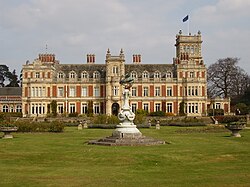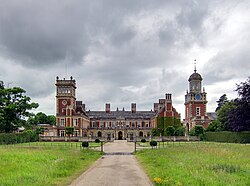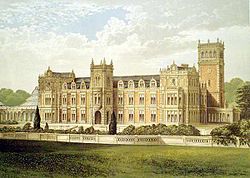Somerleyton Hall: Difference between revisions
Created page with "{{infobox house |county=Suffolk |picture=Somerleyton 5.JPG |picture caption=Somerleyton Hall - The garden front |type=Country house |os grid ref=TM493978 |latitude=52.52100 |l..." |
m →Outside links: ioe -> nhle, replaced: {{IoE|282401 → {{NHLE|1198046 |
||
| Line 52: | Line 52: | ||
{{commons}} | {{commons}} | ||
*[http://www.gardenvisit.com/g/som.htm Somerleyton Hall Garden] | *[http://www.gardenvisit.com/g/som.htm Somerleyton Hall Garden] | ||
*{{ | *{{NHLE|1198046}} | ||
[[Category:Museums in Suffolk]] | [[Category:Museums in Suffolk]] | ||
Latest revision as of 09:47, 19 September 2019
| Somerleyton Hall | |
| Suffolk | |
|---|---|
 Somerleyton Hall - The garden front | |
| Location | |
| Grid reference: | TM493978 |
| Location: | 52°31’16"N, 1°40’24"E |
| History | |
| Built 1844 | |
| Country house | |
| Jacobean | |
| Information | |
| Website: | http://www.somerleyton.co.uk |
Somerleyton Hall is a country house in the village of Somerleyton near Lowestoft, Suffolk. The hall is Grade-II* listed, and its landscaped park and formal gardens are also separately Grade-II* listed on the Register of Historic Parks and Gardens.[1][2]
The formal gardens cover 12 acres and form part of the 5,000-acre estate. They feature a yew hedge maze, one of the finest in Britain, created by William Andrews Nesfield in 1846, and a ridge and furrow greenhouse designed by Joseph Paxton, the architect of The Crystal Palace.[3] There is also a walled garden, an aviary, a loggia and a 300-foot-long pergola, covered with roses and wisteria. The more informal areas of the garden feature rhododendrons and azaleas and a fine collection of specimen trees.
The kitchen garden and the stable court are both listed Grade II*.[4][5] The ridge and furrow glasshouses north of the kitchen garden are listed Grade II.[6]
Several pieces of garden ornaments and statuary are listed at Somerleyton Hall; these include the statue of Atlanta, the group of four urns around the sundial, as well as the sundial, all are listed listed Grade II.[7][8] In the formal gardens, the four urns in the centre and the four stone troughs are both listed Grade II.[9][10]
The remains of the Winter Garden and the boundary walling to the formal gardens are listed Grade II.[11][12] The cistern at the south of the terrace to and the retaining wall to the garden front are listed Grade II.[13][14] The screen wall to entrance front of the hall is Grade II listed.[15]
The South Lodge and the gates to Somerleyton Hall are listed Grade II.[16]
History

In 1240 a manor house was built on the site of Somerleyton Hall by Sir Peter Fitzosbert, whose daughter married into the Jernegan family. The male line of the Fitzosberts ended, and the Jernegans held the estate until 1604.
In 1604 John Wentworth bought the estate. He transformed Somerleyton Hall into a typical East Anglian Tudor-Jacobean mansion. It then passed to the Garney family.
The next owner was Admiral Sir Thomas Allin, a native of Lowestoft. He took part in the Battle of Lowestoft (1665) and the Battle of Solebay at Southwold in 1672. Eventually the male line of that family also died out.
In 1843 Somerleyton Hall and Park were bought by the prosperous entrepreneur and MP Samuel Morton Peto. For the next seven years he carried out extensive rebuilding, creating an Anglo-Italian architecture masterpiece.[17] Paintings were specially commissioned for the house, and the gardens and grounds were completely redesigned. Peto employed Prince Albert's architect John Thomas; the clock tower houses a clock designed by Benjamin Vulliamy. Peto had garden features designed by William Andrews Nesfield and Joseph Paxton. Peto's son, Harold Peto, became a noted garden-designer, but it is not known whether he was influenced by the gardens of Somerlyton.

In 1863 the Somerleyton estate was sold to Sir Francis Crossley of Halifax, Yorkshire who, like Peto, was a philanthropist, a carpet manufacturer, and a Member of Parliament. Sir Francis' son Savile was created Baron Somerleyton in 1916.
The lake at Somerleyton Hall was used by Christopher Cockerell, the inventor of the hovercraft, to carry out his early experiments.
The house is now held by Hugh Crossley, 4th Baron Somerleyton and inhabited by the family. The family motto is 'Everything that is good comes from above'. In 1998 Lord and Lady Somerleyton commissioned the artist Jonathan Myles-Lea, a specialist in country houses, gardens and estates, to paint Somerleyton Hall.
In popular culture
The house and its grounds featured as the principal location in "Neck", the sixth episode in the first series of Tales of the Unexpected (1976), and in episode 2 of the 1989 UK TV series, Interceptor.
The house and grounds feature prominently in W. G. Sebald's 1995 novel The Rings of Saturn.
The house and grounds were used to stand in for Sandringham House in Stephen Poliakoff's 2003 television drama The Lost Prince.
Notes
- ↑ National Heritage List 1198046: Somerleyton Hall
- ↑ National Heritage List 1000188: Somerleyton Park
- ↑ https://web.archive.org/web/20120328111057/http://www.somerleyton.co.uk/hallgardens/gardens_maze.php "Gardens & maze" at somerleyton.co.uk]
- ↑ National Heritage List 1031936: Kitchen garden of Somerleyton Hall
- ↑ National Heritage List 1352646: Stable Court to Somerleyton Hall
- ↑ National Heritage List 1198195: Ridge and furrow glasshouses 15 meters to north of kitchen garden of Somerleyton Hall
- ↑ National Heritage List 1352663: Group of 4 urns around sundial in formal gardens of Somerleyton Hall
- ↑ National Heritage List 1031933: Sundial in formal gardens of Somerleyton Hall
- ↑ National Heritage List 1031934: Group of 4 urns in centre of formal gardens of Somerleyton Hall
- ↑ National Heritage List 1352633: Group of 4 stone troughs in formal gardens of Somerleyton Hall
- ↑ National Heritage List 1031930: Remains of Winter Garden of Somerleyton Hall
- ↑ National Heritage List 1352662: Boundary walling to formal gardens of Somerleyton Hall
- ↑ National Heritage List 1031935: Cistern at South End of terrace to garden front of Somerleyton Hall
- ↑ National Heritage List 1031931: Retaining wall of terrace to garden front of Somerleyton Hall
- ↑ National Heritage List 1198069: Screen Wall to entrance front of Somerleyton Hall
- ↑ National Heritage List 1031953: South Lodge and gates of Somerleyton
- ↑ "Somerleyton Hall". BBC Suffolk. http://www.bbc.co.uk/suffolk/360/views/somerleyton_hall2.shtml. Retrieved 20 January 2013.
Outside links
| ("Wikimedia Commons" has material about Somerleyton Hall) |
- Somerleyton Hall Garden
- National Heritage List 1198046: Somerleyton Hall
